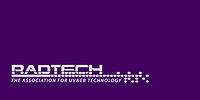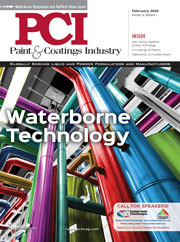RadTech 2020 Featured Many Advancements in UV/EB Curing

RadTech held its 17th biennial conference and exhibition dedicated to UV/EB technology March 8-11, 2020, at Disney Coronado Springs in Orlando, Florida. With more than 100 presentations and 80+ exhibitors, the latest innovations in UV LEDs, 3D printing materials, printing and packaging, coatings, formulations and more were featured.
The Best Paper honor was given to Karl Swanson and Sage Schissel, PCT Ebeam and Integration, LLC, Davenport, IA, for their presentation on “Attainable Sustainable: Using Electron Beam Technology in Compostable Flexible Packaging.” And the Best Student Paper was awarded to Nicole L. K. Thiher, University of Iowa; Erin Peters, Rockridge High School, Taylor Ridge, IL; Sage M. Schissel, PCT Ebeam and Integration; and Julie L.P. Jessop, Mississippi State University, School of Chemical Engineering. They presented on “Comparison of UV- and EB-Initiated Polymerizations Based on Equivalent Radical Concentration.”
RadLaunch, the unique idea accelerator for UV/EB technology start-ups, students and innovators, selected five key technology developers for 2020 and a university award. RadLaunch winners included:
- HARP (High-Area Rapid Printing), Azul 3D;
- Solvent-Free Radical Photopolymerization That Continues its Extensive Post-Conversion in the Dark, Team from University of Colorado;
- Next-Generation Energy Storage with UV Curing of Novel Polymer Electrolyte Materials, The Hosein Research Group, Syracuse University;
- Bio-Based 1,5-Pentanediol: A New Renewable Monomer for the Radcure Industry, Pyran LLC;
- Real-Time Feedback Controlled Monomer Conversion: a New Paradigm for UV Curing Process Control, Eindhoven University of Technology’s High Tech Systems Center and TNO (Eindhoven, The Netherlands);
- Novel UV-Initiated Dual-Curing Thermoset Materials Suitable for 3D Printing, Hamidreza Asemani, Professor Vijay Mannari; Coatings Research Institute, Eastern Michigan University, Ypsilanti, MI.
PCI congratulates all of this year’s winners.
Trends in Curing
At this year’s RadTech, PCI caught up with JP Masson, Director of Sales and Marketing, Nagase America, Chemicals Division, to discuss trends in the curing market.
He stated that free radical cure has been the predominant UV chemistry for many years, but the growth of 3D printing brought a renewed interest in cationic cure, due to its enhanced mechanical properties. Cationic systems shrink less than free radical, therefore are less brittle when cured in thick layers. Initially, formulators shied away from cationic due to the limited portfolio of available products. No longer the case today; an extensive range of products is commercially available that has allowed the development of sophisticated formulations. This benefits not only 3D printing, but other applications such as coatings or adhesives with specific required properties. He noted that an interesting aspect of cationic cure is its ability to be hybridized with free radical, allowing fast cure with improved performance properties.
Masson added that as 3D printing companies continue to push the envelope for the adoption of additive manufacturing as a viable mass production technology, formulators of photopolymer-based systems are working on developing resin systems that meet industry standards. This has led to the need for novel raw materials that, for example, enable effective flame retardancy in the transportation industry. Such materials are available, but have not been widely used in 3D printing. Curated distribution networks play an important role in giving formulators access to the right solutions for their products.
To support the trend toward cationic, Nagase assembled an extensive portfolio of raw materials, enabling formulators to explore the full potential of that technology. Innovative monomers, photoacid generators or photosensitizers can be used in 100% cationic formulations, but also offer very interesting benefits in developing hybrid systems. Hybrid systems that, for example, combine the cure speed of acrylates with the better mechanical properties of cationic materials.
Masson also noted that the use of LED as a source of UV light is gaining interest due mainly to its better energy efficiency versus traditional sources of light. A challenge faced by formulators is the limited array of photoinitiators suitable for UV-LED use, due to emission spectra being shifted to higher wavelengths.
From a formulation point of view, this can be addressed with photosensitizers, a type of raw material that will absorb light at the higher wavelengths typical of LED. Once excited by light from LED lamps, photosensitizers transfer energy to traditional photoinitiators and kick start the polymerization reaction. This technology is suitable for both free radical and cationic chemistries.
He concluded by stating that one notable aspect of photosensitizers in free radical formulations is their ability to combine with a photoinitiator, mimicking the performance of a photoinitatior with a different absorption spectrum. Considering that certain photoinitiators have seen fluctuations in supply conditions in recent years or are subject to re-classification, the use of more favorable photoinitiators is rendered possible by photosensitizers. Download the whitepaper at nagaseamerica.com/radtech-2020.
Looking for a reprint of this article?
From high-res PDFs to custom plaques, order your copy today!









